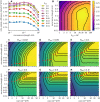Shared input and recurrency in neural networks for metabolically efficient information transmission
- PMID: 38394341
- PMCID: PMC10917264
- DOI: 10.1371/journal.pcbi.1011896
Shared input and recurrency in neural networks for metabolically efficient information transmission
Abstract
Shared input to a population of neurons induces noise correlations, which can decrease the information carried by a population activity. Inhibitory feedback in recurrent neural networks can reduce the noise correlations and thus increase the information carried by the population activity. However, the activity of inhibitory neurons is costly. This inhibitory feedback decreases the gain of the population. Thus, depolarization of its neurons requires stronger excitatory synaptic input, which is associated with higher ATP consumption. Given that the goal of neural populations is to transmit as much information as possible at minimal metabolic costs, it is unclear whether the increased information transmission reliability provided by inhibitory feedback compensates for the additional costs. We analyze this problem in a network of leaky integrate-and-fire neurons receiving correlated input. By maximizing mutual information with metabolic cost constraints, we show that there is an optimal strength of recurrent connections in the network, which maximizes the value of mutual information-per-cost. For higher values of input correlation, the mutual information-per-cost is higher for recurrent networks with inhibitory feedback compared to feedforward networks without any inhibitory neurons. Our results, therefore, show that the optimal synaptic strength of a recurrent network can be inferred from metabolically efficient coding arguments and that decorrelation of the input by inhibitory feedback compensates for the associated increased metabolic costs.
Copyright: © 2024 Barta, Kostal. This is an open access article distributed under the terms of the Creative Commons Attribution License, which permits unrestricted use, distribution, and reproduction in any medium, provided the original author and source are credited.
Conflict of interest statement
The authors have declared that no competing interests exist.
Figures






References
-
- Barlow HB. Possible Principles Underlying the Transformations of Sensory Messages. In: Sensory Communication. The MIT Press; 1961. p. 217–234.
MeSH terms
LinkOut - more resources
Full Text Sources

